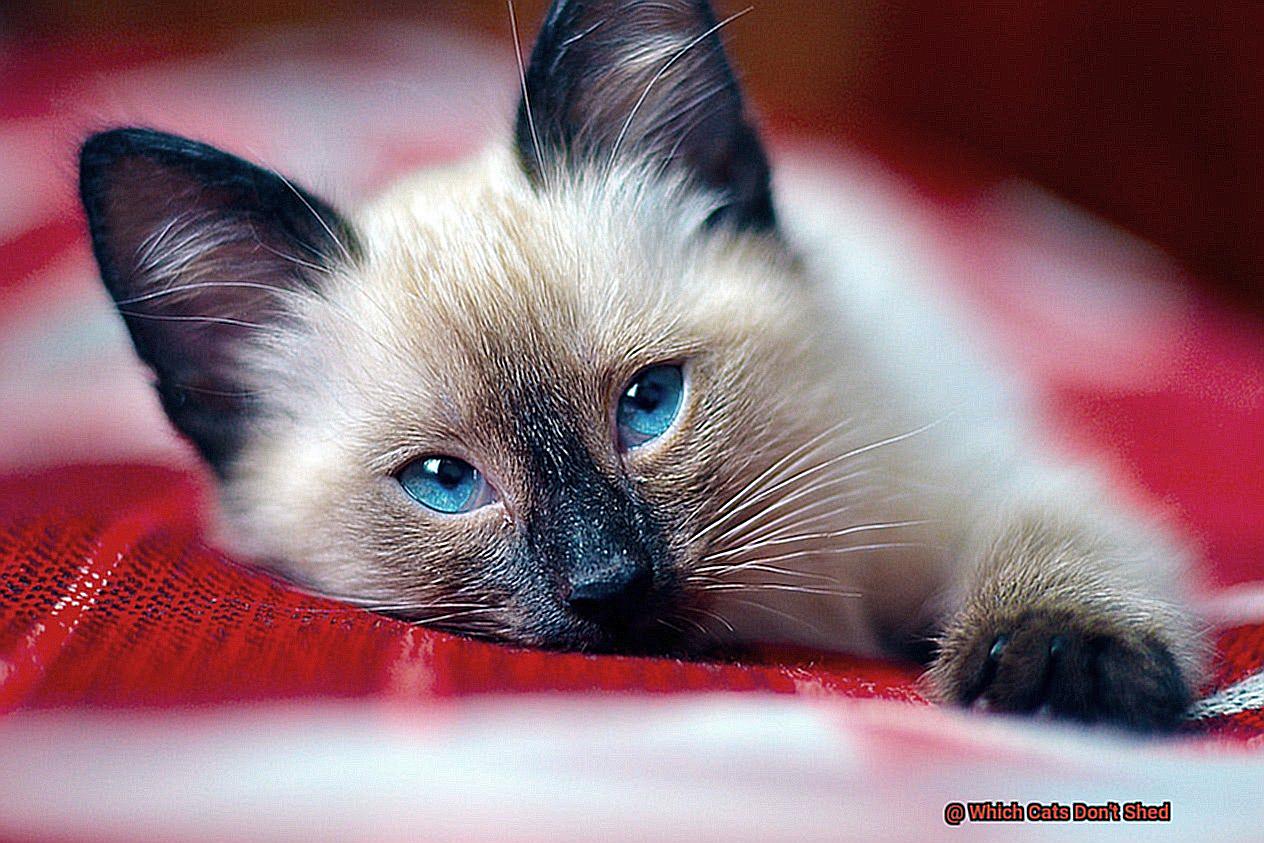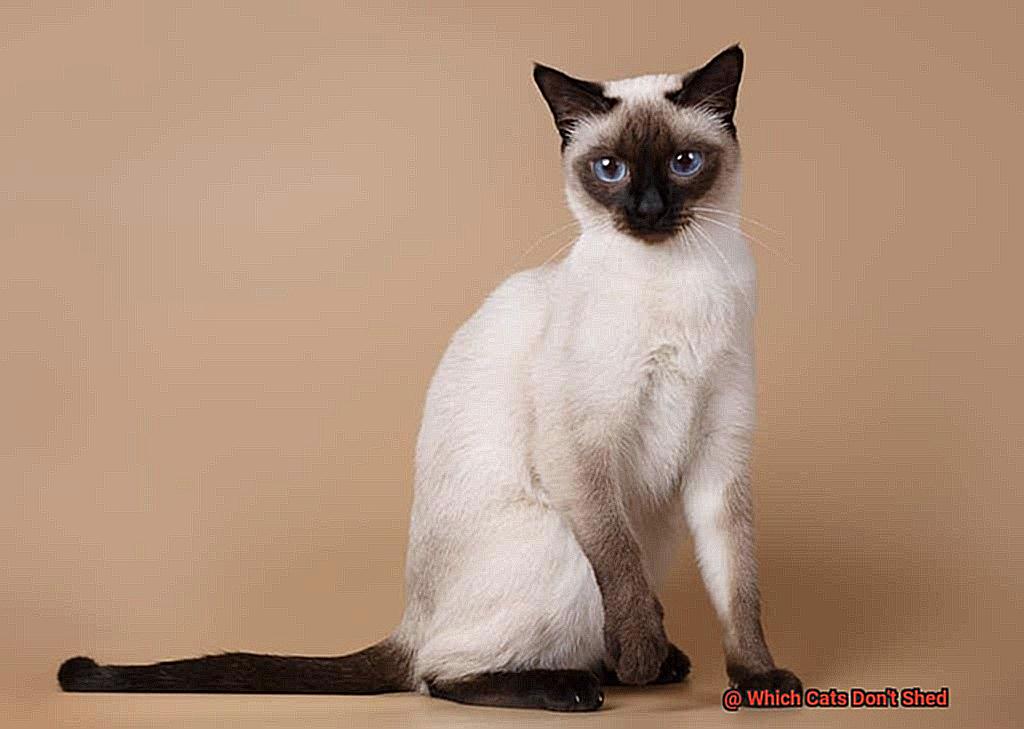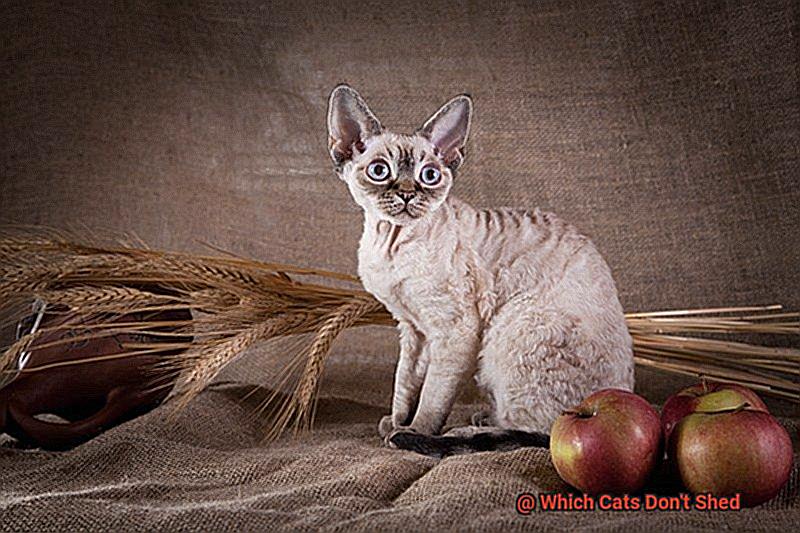Are you tired of sweeping up cat hair from every surface in your home?
Do allergies prevent you from enjoying the company of a furry friend? Fear not, as there are cats out there that shed minimally and produce fewer allergens.

While no cat is completely free of shedding, certain breeds have gained popularity for their hypoallergenic qualities and low-shedding coats. These feline wonders have become a favorite among cat lovers who want the companionship of a pet without the added hassle of constant grooming and cleaning.
So which cats are these non-shedding marvels? The Sphinx, with its hairless body and minimal dander production, is an excellent option.
Another breed to consider is the Balinese, whose long hair lacks an undercoat, making it less likely to cause allergic reactions. If you’re looking for something a little more unique, the Devon Rex and Cornish Rex both have curly coats that shed very little.
The Siberian cat also makes for a great low-shedding companion with its soft and almost wiry fur. For those seeking a happy and hair-free home, non-shedding cats may be just what you need.
So, let’s find out.
What is Shedding?
Shedding is a natural process in which cats lose their old or damaged fur to make way for new growth.
While shedding is normal, excessive shedding can be a problem for some cat owners, especially those who suffer from allergies or simply do not want to deal with the constant cleaning. The amount of shedding a cat experiences is influenced by several factors, including breed, age, and health status.
However, there are hypoallergenic breeds like the Sphynx, Cornish Rex, Devon Rex, Russian Blue, and Bengal that shed less than other breeds. These breeds are perfect for those who want a cleaner home without sacrificing the joy of having a furry friend.
During shedding season, which typically occurs in the spring and fall, cats may shed more than usual due to changes in daylight hours and temperature fluctuations. But don’t worry – regular grooming can help control shedding by removing loose fur before it has a chance to fall out on its own.
Brushing or combing your cat’s coat regularly and providing them with a healthy diet and plenty of hydration can also help reduce shedding. If you notice excessive shedding or bald patches on your cat’s coat, it’s important to consult with your veterinarian to rule out any underlying health issues.
Your vet can recommend specific treatments or dietary changes that can help reduce shedding and keep your cat healthy. In conclusion, shedding is a natural part of a cat’s life, but there are ways to control it and minimize its impact on your home.
What is a Hypoallergenic Cat?
Hypoallergenic cats are breeds that produce fewer allergens compared to other cats, which means people who are allergic to cats may be able to tolerate living with them better. It’s important to note, however, that no cat breed is entirely hypoallergenic, and some people may still experience allergic reactions.

But why do some cats produce fewer allergens? These cats have less Fel d 1 protein in their saliva and skin oil, which is the main allergen that triggers allergies in humans.
Some hypoallergenic breeds include the Siberian, Balinese, Devon Rex, and Sphynx. These breeds also tend to shed less, further reducing allergen levels in the environment.
However, it’s essential to keep in mind that just because a cat is labeled as hypoallergenic doesn’t mean it will automatically be an excellent fit for someone with allergies. Spending time with a specific cat before adoption is recommended to see how your body reacts.
Additionally, keeping the home clean and using air purifiers can help reduce allergen levels in the environment. Don’t give up hope of having a feline friend if you suffer from allergies.
Consider looking into hypoallergenic cat breeds and taking the necessary precautions to create a comfortable environment for both you and your furry companion.
The Sphynx: The Hairless Cat
This breed is known for their unique appearance, friendly personality, and most importantly, their hairlessness. Don’t be fooled though – Sphynx cats aren’t completely bald.
They have a thin layer of fuzz covering their bodies, which can range in color from white to black. Despite this, they still have a strikingly unique look with their wrinkled skin and large ears.

One of the biggest benefits of owning a Sphynx is their minimal grooming needs. Without fur, they don’t require regular brushing or grooming.
However, they do need regular baths to keep their skin clean and healthy. But hey, what’s a little bath time compared to hours of shedding cleanup?
Sphynx cats are also known for their outgoing personalities. They love human interaction and thrive on attention.
Plus, they’re intelligent and curious, always in need of mental stimulation and plenty of toys to play with. Another benefit of the Sphynx is that they don’t shed like other cats.
While they still produce allergens that can trigger allergies in some people, their lack of fur means less dander spread throughout the house. But before adopting a Sphynx, it’s important to consider their unique needs.
Because they don’t have fur, they’re more sensitive to temperature changes and need to be kept warm in colder weather. They also require regular attention to their ears and skin.
They are friendly, low-maintenance pets that require minimal grooming but regular bathing.
The Cornish Rex: Short Curly Hair
The Cornish Rex might just be the answer to your prayers.
This unique breed of cat is known for its short, curly coat that is incredibly soft to the touch and has a gentle wave to it. Unlike most other cats, the Cornish Rex has only one layer of hair, which means they shed less and require less grooming.
But the Cornish Rex’s distinctive appearance doesn’t stop at their coat. With their arched back, long slender legs, and large ears, these cats are sure to turn heads.
And their playful and active personality is just as striking as their looks. These cats love to run around and play, making them great companions for families with children or other pets.

Of course, like any pet, the Cornish Rex requires some level of care. While they don’t shed much, their coat still needs occasional brushing or combing to remove any dead hair or tangles.
And it’s important to keep in mind that this breed can be prone to certain health issues such as hypertrophic cardiomyopathy, which is a heart condition. Choosing a reputable breeder and making sure your cat receives regular checkups from a veterinarian can help ensure their health and longevity.
So, if you’re looking for a cat that doesn’t shed much but still has plenty of personality and energy, the Cornish Rex could be the perfect fit for you.
The Devon Rex: Less Dander and Less Shedding
The Devon Rex’s curly, soft coat requires minimal grooming and sheds less due to having fewer hair follicles than other cats. This makes it an ideal pet for those with allergies or sensitivities to cat hair.
However, it’s important to note that no cat is completely hypoallergenic, as the Devon Rex still produces some allergenic proteins in their saliva and skin. But the benefits of the Devon Rex don’t stop there.
This breed is also known for its playful and affectionate personality. They’re intelligent and can even learn tricks, making them the perfect companion for interactive playtime.
Plus, their loyalty and love for attention means they’ll follow you around the house and snuggle up with you at night. It’s important to keep in mind that the Devon Rex does require attention and stimulation to stay happy and healthy.
The Russian Blue: Dense Fur with Low Shedding
The Russian Blue is the perfect choice for those seeking a stunning cat with a gentle nature and low-shedding fur.
This breed’s striking blue-grey coat is dense, plush, and soft to the touch. Comprised of two layers – an undercoat and an outercoat – this thick fur works together to keep Russian Blues warm in their native Russia.
However, despite their thick coat, these cats are considered low-shedders, making them an ideal fit for allergy sufferers or those who prefer a clean home. But what’s even more impressive about these cats is their fastidious self-grooming habits.
You won’t have to spend hours brushing knots and tangles out of their luscious fur. Instead, Russian Blues take care of their own grooming needs, keeping their coat clean and shiny with minimal effort on your part.
However, it’s not just their low-shedding fur that makes these cats such great companions. They’re also known for their affectionate personalities and playful nature, making them a popular choice for families and individuals alike.
The Bengal Cat: Low Allergen and Low Shedding
This unique breed is a relatively new addition to the feline family, but they’re quickly gaining popularity for their stunning coat patterns and low shedding. The Bengal cat’s coat is short and dense, requiring minimal grooming.
But what’s even more impressive is their low shedding. Unlike other cats with rough textured fur, the Bengal cat’s coat is made up of soft, fine hair that doesn’t shed as much, making them an ideal choice for allergy sufferers or those who simply don’t want to deal with excessive shedding.
But wait, there’s more. Bengal cats are also known for having a low allergen level.
This means they produce less of the Fel d 1 protein, which is the protein that causes most cat allergies. While no cat is completely hypoallergenic, Bengal cats are a great option for those who are sensitive to the Fel d 1 protein.
It’s important to note that despite their low shedding and allergen levels, Bengal cats still require regular grooming and care. They should be brushed once a week to keep their coat healthy and shiny.
And because they’re an active breed, they need plenty of exercise and mental stimulation to prevent boredom and destructive behavior. Overall, the Bengal cat is an excellent choice for anyone looking for a low shedding and low allergen cat breed.
nV7ofCPL__U” >
Conclusion
In conclusion, cat lovers who are tired of constantly cleaning up fur or dealing with allergies can breathe a sigh of relief – there are several breeds that don’t shed as much as others.
While it’s true that no cat is entirely free from shedding, certain breeds have become popular for their hypoallergenic qualities and low-shedding coats. If you’re looking for a hair-free home, the Sphinx, Balinese, Devon Rex, Cornish Rex, Siberian cat, Russian Blue and Bengal cat are all great options.
It’s important to remember that even hypoallergenic cats still produce some allergens and require proper care. Before adopting a new feline friend, it’s recommended to spend time with them to see how your body reacts.
Regular grooming is also essential in controlling shedding by removing loose fur before it has a chance to fall out on its own. By understanding shedding in cats and taking steps to control it through grooming and proper care, you can enjoy a cleaner home and a happier feline companion.
So why not consider adding one of these low-shedding breeds to your family? With their unique appearances and playful personalities, they’re sure to bring endless joy into your life without any hassle or allergy issues.







